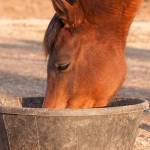Study: Hempseed Meal Pellets Palatable and Acceptable to Horses

Feed-related costs represent one of the most expensive aspects of horse ownership, one reason why the feed industry is always looking for economical feedstuffs that meet the nutritional needs of horses. Hempseed has recently gained attention as a potential “alternative feed ingredient.”
“Hempseed meal has many pleasing attributes for equine diets, including high crude protein, crude fat, and neutral detergent fiber in combination with a low nonstructural carbohydrate content of less than 6.5% dry matter,” said Ryon Springer, M.S., research coordinator at Kentucky Equine Research.
Having such a low nonstructural carbohydrate content makes hempseed meal particularly pleasing for owners of metabolic horses with insulin dysregulation that are at risk of hyperinsulinemia-associated laminitis.
But will horses eat hempseed meal?
To answer this question, a research team conducted two studies: one assessing palatability and the other acceptance. In both arms of the study, six mature horses were included.*
In the palatability study, hempseed meal pellets were compared to soybean meal pellets, rice bran pellets, and beet pulp pellets. Horses were offered hempseed meal pellets in one bucket and one of the other three pellets in a second bucket hung in the stall. Horses were allotted ten minutes to consume the feeds, and cameras mounted above the feed buckets recorded which feed was smelled and eaten first.
“Consumption of hempseed meal pellets was greater than both the soybean meal pellets and beet pulp pellets but was similar to the rice bran pellets,” said Springer. “Soybean meal, rice bran, and beet pulp pellets are common feedstuffs consumed well by horses, suggesting that hempseed meal is highly palatable.”
To assess acceptability, horses were offered 1 kg of hempseed meal pellets in a bucket over two five-minute feeding periods separated by one hour each day for six consecutive days. In between those offerings, horses were fed 1 kg coastal Bermuda grass hay.
“After four days of feeding the hempseed meal pellets at two separate offerings, acceptability of the feed increased until day 6. Hay consumption during days 4 to 6 also decreased, indicating the horses preferred the hempseed meal pellets. The horses likely were replacing the fiber from their hay with the fiber found within hempseed meal pellets,” Springer shared.
The research team therefore concluded, “In equine rations, hempseed meal pellets may serve as an acceptable replacement to more common feedstuffs.”
Based on this study, hempseed meal pellets are safe when fed at a rate of 1 kg/day for six consecutive days.
“However, hempseed meal has only been approved by the Association of American Feed Control Officials (AAFCO) for feeding laying hens,” cautioned Springer. “Few states allow for the commercial feeding of hempseed meal to livestock or pets; thus, many feed manufacturers are not allowed to sell products containing hempseed meal to horse owners. Many of the equine associations ban the use of products containing cannabinoids (CBD and THC), so feeding hempseed products is not recommended for competition horses.”
While the low-NSC, high-fat, and high-fiber nutrient profile is appealing due to its likely low glycemic response, it is recommended to use other feedstuffs such as soybean meal, rice bran, and beet pulp to achieve a similar nutrient profile until approval is granted by AAFCO, Springer advised.
If you are interested in feeding a low-NSC product with high fat and fermentable fiber, try Re-Leve.
*Springer, R.W., A. C. Mason, T.D. Cross, K.A. Guay, R.H. Raub, K.B. Wellmann, and T.N. Jones. 2023. Assessment of the palatability and acceptability of hempseed meal pellets in horses compared to mainstream feedstuffs. Journal of Equine Veterinary Science 131:104929.








